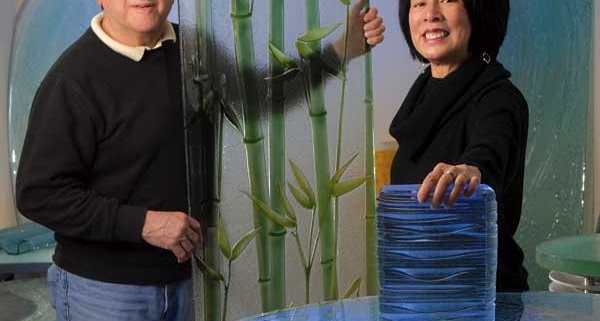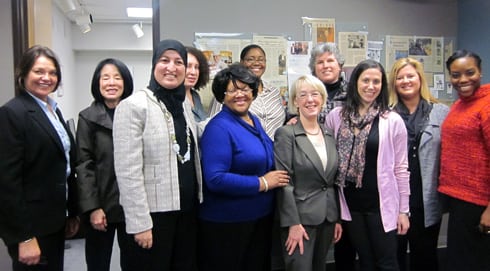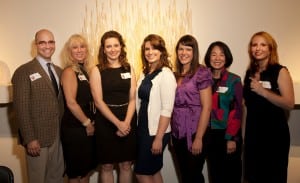[vc_row][vc_column width=”1/2″ el_class=”new-left-side”][vc_column_text] The design world is buzzing with excitement to explore glass as a functional and dramatic style element. Being a motivated and cutting edge style enthusiast, you hop online to find what kind of glass countertop would be best for your kitchen remodel or what glass table top would add an eye catching element to your outdoor patio. Soon you find yourself staring at your computer screen, reading terms like “fused”, “cast”, “frit” and “kiln-formed” not knowing exactly what they mean. This article is our attempt to explain these terms so you may gain a working knowledge of glass styles and applications.[/vc_column_text][/vc_column][vc_column width=”1/2″ el_class=”new-right-side”][vc_column_text]By the Time You Read this Article You Will Know:
The design world is buzzing with excitement to explore glass as a functional and dramatic style element. Being a motivated and cutting edge style enthusiast, you hop online to find what kind of glass countertop would be best for your kitchen remodel or what glass table top would add an eye catching element to your outdoor patio. Soon you find yourself staring at your computer screen, reading terms like “fused”, “cast”, “frit” and “kiln-formed” not knowing exactly what they mean. This article is our attempt to explain these terms so you may gain a working knowledge of glass styles and applications.[/vc_column_text][/vc_column][vc_column width=”1/2″ el_class=”new-right-side”][vc_column_text]By the Time You Read this Article You Will Know:
- Unique aspects of Kiln-Formed Glass, Surface Textured Glass and Introducing Color Elements.
- How each technique can be used individually or combined resulting in Functional Works of Art.
The joy in using glass as our artistic medium is the versatility it affords by utilizing one or several techniques when forming a custom design. Glass is a fluid substance allowing tremendous variation and range of artistic expression, while requiring careful planning and technique. Every well versed interior designer, artist and style enthusiast knows that the key to working with your palette is to first get to know it. Instead of colors, we’re going to get familiar with the palette of glass.[/vc_column_text][/vc_column][/vc_row][vc_row][vc_column width=”1/2″ el_class=”new-left-side”][vc_column_text]Kiln-Formed Glass
Kiln-formed glass, also known as “warm” glass, is created by placing glass in a kiln or oven and melting it to form different textures or thicknesses. The oven temperatures typically range from 1400 to 1600 degrees Fahrenheit. This category includes the techniques of Slumping, Fusing/Layering and Casting.
Slumped Glass is created by using a combination of heat, gravity and bending to mold flat glass into textured and/or three-dimensional shapes. The texture is created within the kiln, resulting in designs that range from an overall organic impression to a precise representational relief. Slumped glass is one of the more cost-effective and versatile types of art glass, and the techniques applied work well for either horizontal installations, e.g. table surfaces, counters and vanities; or vertical installations, e.g. door inserts, windows and partitions. With this technique, we were able to recycle a post-industrial glass panel into the lovely wine door pictured here.[/vc_column_text][/vc_column][vc_column width=”1/2″ el_class=”new-right-side”][vc_column_text]
Fused / Layered Glass is created by stacking panels of glass together in the kiln and heating it until the pieces melt together. When you see glass that has visible layers, you are encountering fused glass. This glass obtains a slight texture as a result of the fusing process. Fused / Layered glass looks best when we create organic edges that look scalloped or wavy, as seen in the picture of a layered glass desk. This type of glass works best as a horizontal installation and, in combination with the edge treatment, is very eye pleasing on glass vanities, kitchen counters, table tops, and the like. Color elements can be added between the layers for striking design features.[/vc_column_text][/vc_column][/vc_row][vc_row][vc_column width=”1/2″ el_class=”new-left-side”][vc_column_text]
Cast Glass is created by using tiny pieces of crushed glass (called cullet) which is melted in a custom mold in our kiln. Bubbles are the unique characteristic of cast glass, created when air is trapped between the cullet pieces at high temperatures. We are also able to create an ‘iced’ or ‘halo’ look if desired. Cast glass is found most often in horizontal glass surfaces with a thickness between ¾” to 1 ½”, and can be used in counter tops, tables, mantles, transaction tops, and other novel projects; and as vertical installations, e.g. balustrades, shower enclosures, and room partitions. The cast glass technique is the most time and energy intensive, but offers the most all-around possibilities of the kiln-formed glass with virtually limitless color and thickness; it can be cut to any shape, and it diffuses light beautifully with varying levels of opacity possible. The picture to the right shows a sea green cast glass kitchen countertop with medium opacity.[/vc_column_text][/vc_column][vc_column width=”1/2″ el_class=”new-right-side”][vc_column_text]Surface Textured Glass
Surface textured glass is created when the glass surface is sandblasted to produce a textured non-glossy surface. The varying techniques include Etching, Glue-Chipping and Carving.
Etched Glass displays a technique to impose decorative patterns on otherwise plain glass by using a thin film “resist” to cover the areas to remain transparent. This type of glass allows for a varying degrees of obscurity by removing the shine from the glass. The application of frosted / etched glass is typically on vertical installations, and, while traditionally used in privacy oriented projects, has expanded to other areas of the home or office including closet doors and even desk tops. This process can be fairly economical and may be applied on all types of glass ranging from simple 1/8″ glass to kiln-formed custom art glass pieces.[/vc_column_text][/vc_column][/vc_row][vc_row][vc_column width=”1/2″ el_class=”new-left-side”][vc_column_text]
Glue-Chipped Glass results from a process of applying hot organic-based glue to the surface of previously etched glass. As the glue dries it shrinks, pulling chips of the glass surface away over many hours.
Carved Glass is an artistic statement that involves sandblasting to varying depths and levels, giving the glass a “hand carved” appearance. Carving adds an element of three-dimensional depth to the glass, and requires a high degree of skill. As with etching, carved glass is usually seen in vertical installations, e.g. entries, partitions and walls.
Surface Texture not only adds depth, design and interest to your glass piece, it tells your unique story.
[/vc_column_text][/vc_column][vc_column width=”1/2″ el_class=”new-right-side”][vc_column_text]Introducing Color Elements
Colored glass might seem a simple concept, but there are many ways to add color elements to glass, either along with or in addition to any of the kiln-formed or surface textured techniques. Colored glass techniques include the use of Glass Frit, Painting and Silvering.
Glass Frit is composed of tiny pellets or powders of colored glass which are applied as a part of the kiln-forming process. This technique offers a wide variety of colors and intensities, from subtle to bold and usually works best when creating shapes or designs in our low-iron or clear glass. Frit is often used in tandem with layering to introduce color at various depths within the finished piece. The major benefit of using frit is that it is fused right into the finished piece allowing color that is exceptionally resistant to scratches and will not fade or change color with time as other color elements can. Frit remains congruent with the main glass content of the piece and will look brilliant and bold for decades to come.[/vc_column_text][/vc_column][/vc_row][vc_row][vc_column width=”1/2″ el_class=”new-left-side”][vc_column_text]
Painted Glass is accomplished by applying glass paint to the back or textured side of the glass, and the piece is then viewed from the front or glazed side. Painting is an expressive and versatile transformative tool because the color range is unending, allowing for subtle to bold design or overall tint. This technique is the perfect solution when an exact color match is required. Painting is also easier to control than frit, making detailed and life-like designs possible. The paint is applied with brushes for bold strokes, sprays for even coats, by airbrush to achieve blends and gradients, or in any combination thereof. Painted glass is most often found in vertical surfaces, e.g. doors, windows, and wall coverings. The example photograph to the left shows a bamboo pattern slumped in the glass and then painted to achieve a 3-dimensional life-like quality.[/vc_column_text][/vc_column][vc_column width=”1/2″ el_class=”new-right-side”][vc_column_text]
Silvered Glass is created by adding a shiny metallic surface to the underside or textured side of kiln-formed glass. This is the same process used to create a regular bathroom mirror, but we often apply the mirror after we have slumped a texture into the glass, which creates a piece able to capture, reflect and refract the light like no other. We can also wipe away some of the silver, creating a semi-mirror which lets some light through while creating a partial reflection. To go even further, we can incorporate back-painting with a partially mirrored and slumped interior window as in the picture shown here.[/vc_column_text][/vc_column][/vc_row][vc_row][vc_column width=”1/2″ el_class=”new-left-side”][vc_column_text]Functional Works of Art
In purchasing a custom glass piece you are acquiring a functional work of art. Our architectural art glass offers a durable surface made for everyday use, with a custom design which reflects the authenticity of your vision and offers the selective indulgence you desire. Focusing on your end vision and overall impression is our main goal, as we use our palette of glass to bring your design to life.
[/vc_column_text][/vc_column][vc_column width=”1/2″ el_class=”new-right-side”][vc_column_text]We hope this article has given you a better understanding of the options available at Glassworks, Inc., and with some new concepts to your toolkit, you are now conversing like an art glass pro!
Give us a call to continue the conversation, at our office (206) 441-4268, toll free 1 (888) 441-4268 or you can contact us via email.
For more information on our glass, our process and our people, feel free to read more articles in our Glassworks, Inc ongoing educational series:
Architectural Art Glass 101[/vc_column_text][/vc_column][/vc_row][vc_row][vc_column][vc_custom_heading text=”Latest News” font_container=”tag:h2|font_size:55px|text_align:center|color:%23000000|line_height:60px” google_fonts=”font_family:Lora%3Aregular%2Citalic%2C700%2C700italic|font_style:400%20regular%3A400%3Anormal” el_class=”latest-news-new-page”][vc_row_inner el_class=”new-post-carousel”][vc_column_inner][na_posts_carousel height=”277px” excerpt=”0″ comment=”none” catg=”none” dot=”false” autoplay=”false” slide_visible=”2″ txtsize=”24px” txtclr=”#000000″ dateclr=”#686868″ descclr=”#888888″ settings=”size:10|order_by:date|order:ASC|post_type:post|categories:20″][/vc_column_inner][/vc_row_inner][/vc_column][/vc_row][vc_row el_class=”get-in-touch-block”][vc_column][vc_custom_heading text=”Have a Vision for your Unique Space? ” font_container=”tag:h2|font_size:55px|text_align:center|color:%23000000|line_height:60px” google_fonts=”font_family:Lora%3Aregular%2Citalic%2C700%2C700italic|font_style:400%20regular%3A400%3Anormal”][vc_custom_heading text=”Get In Touch” font_container=”tag:h2|font_size:55px|text_align:center|color:%23597b7c|line_height:60px” google_fonts=”font_family:Lora%3Aregular%2Citalic%2C700%2C700italic|font_style:400%20regular%3A400%3Anormal” el_class=”get-in-touch-link” link=”url:http%3A%2F%2Fglassworksinc.com%2Fcontact-us%2F|||”][/vc_column][/vc_row]
























